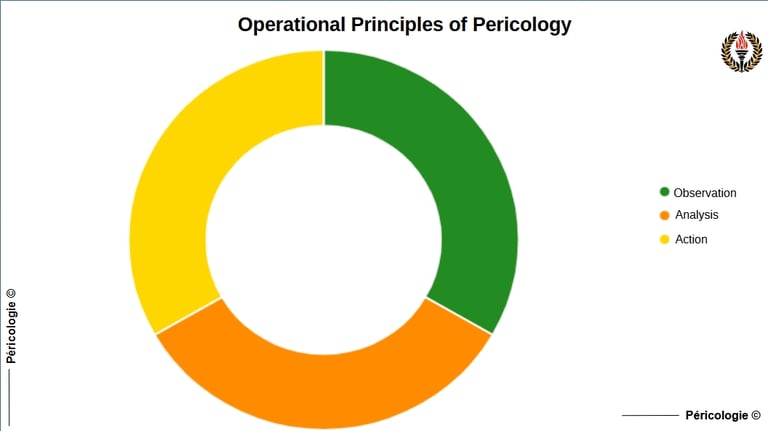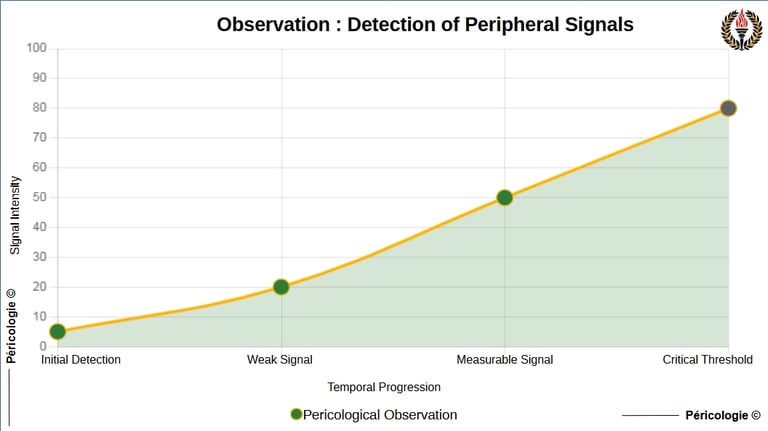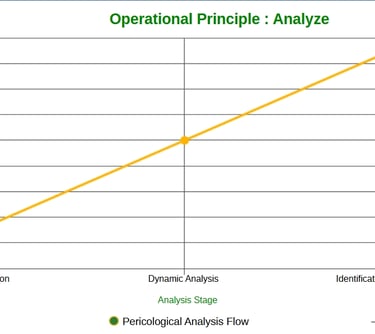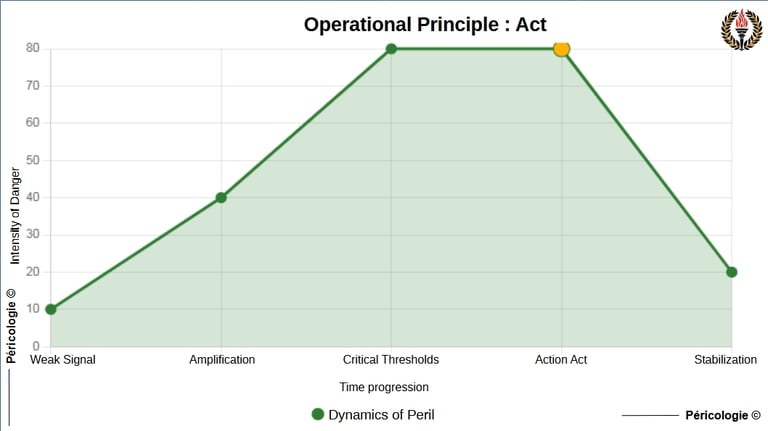The Operational Principles of Pericology
Operational Principles
The "Operational Principles" constitute the fundamental methodological framework of Pericology, structuring the approach to anticipating and preventing systemic perils in three interconnected steps : Observe, Analyze, and Act. These principles guide the pericologist in detecting weak or measurable signals (Observation), assessing the dynamics and critical thresholds of perils (Analysis), and implementing targeted actions to neutralize them before they reach a tipping point (Action). Inspired by the collaborative dynamics of nature, such as the vigilance and response systems of ecosystems, they promote a proactive, adaptable, and contextual approach, without presupposing perfect human cooperation. Unlike reactive crisis management frameworks , these principles are oriented toward peripheral anticipation, aiming to "see first, stop first."


Operational Principles
Diagram of operational principles
Pericological Example
Context : In a regional seaport, recurring delays in the supply chain (unloading containers) threaten to cause major congestion, risking a tipping point (stoppage of port operations). This systemic peril is amplified by weak signals (e.g., micro-failures in automated cranes) and interdependencies (reliance on digital flows for coordination).
Pericological Application : Observer : Pericologists detect weak signals via IoT sensors signaling abnormal slowdowns in cranes (e.g., 10% drop in hourly efficiency). Inspired by fish school vigilance systems, they monitor flows in real time. Analyze : They contrast these signals with historical data and model a positive loop (delays amplifying congestion). Act : A bio-inspired preventive actionis implemented.
Etymology
The term "Principles" derives from the Latin principium ("beginning", "foundation"), designating a structuring basis for action.
"Operational" comes from the Latin operatio ("action", "work"), emphasizing concrete implementation.
Pericological Sources
Observation
In Pericology, "Observation" refers to the methodical and systematic act of detecting weak or measurable warning signals announcing systemic perils in human, biological or technological contexts. The first fundamental pillar of the discipline, it consists of actively scrutinizing the evolutionary dynamics of systems to identify early signs of imbalance, before they reach a tipping point. This observation is inspired by the cooperative dynamics of nature, where species such as meerkats or schools of fish collectively detect threats. Unlike passive surveillance, pericological observation is proactive, anchored in peripheral vigilance, and aims to provide raw data that can be used for analysis and action.


Observation
Observation diagram
Pericological Example
Context : In an interconnected automated factory, micro-variations in machine energy consumption signal a risk of imminent overload, which could lead to systemic failure.
Pericological Application : A pericologist, playing the role of Observer, deploys IoT sensors to monitor energy fluctuations (measurable signals) in real time. Inspired by schools of fish that detect disturbances via coordinated movements, he calibrates the sensors to spot subtle anomalies (weak signals). This early observation makes it possible to identify a risk of overload before it reaches a critical threshold, triggering analysis and preventive action (e.g., load redistribution).
Etymology
The term "observation" comes from the Latin observatio (action of observing, attention), derived from observare (to monitor, guard, examine), formed from ob- (towards, in the direction of) and servare (to keep, protect, observe).
Pericological Sources
Analyze
In the context of Pericology, "Analyze" refers to the methodological step of assessing the importance, underlying causes and dynamics of identified perils, in order to understand their impact potential and critical thresholds. This phase, the second pillar of the pericological methodology, is based on a rigorous and systemic approach to contrast weak and measurable signals detected during observation. Pericological analysis is not limited to a static description, but seeks to model dynamic interactions to anticipate the evolution of perils before they reach a tipping point. It is inspired by the cooperative dynamics of nature, where threat assessment is based on contextual and adaptive understanding, without presupposing prefabricated solutions


Analyze
Diagram of the analysis
Pericological Example
Context : In an interconnected logistics network (e.g., industrial supply chain), a weak signal is detected by the Observer : a local overload at a key node (e.g., delivery delay due to a minor breakdown). This systemic context, where interdependencies amplify dysfunctions (positive loop), requires analysis to avoid a tipping point towards a generalized crisis (e.g., chain paralysis).
Pericological Application : Applied via Holopraxy (sub-branch Cyclosynpraxia for systemic perils), this analysis leads directly to "Act " : proposal of a bio-inspired feedback (e.g.: automatic redistribution of flows, mimicking the self-management of a river ecosystem).
Etymology
The word analyze comes from French, derived from the term analysis, from the medieval Latin analysis, itself borrowed from the ancient Greek ἀνάλυσις (análisis), meaning "dissolution" or "decomposition". Compound of ἀνά (aná , "up", "through") and λύσις (lýsis , "action of untying, resolving"), it evokes the idea of breaking down a whole into its parts to understand its structure and relationships.
Pericological Sources
Act
In the context of Pericology, "Acting" refers to the final operational step in the methodical process aimed at countering systemic perils before they reach a critical threshold or tipping point. It involves implementing concrete, targeted and context-appropriate actions, based on the observation of warning signals and the analysis of peril dynamics. These actions are inspired by the cooperative dynamics of nature to preserve human, biological or technological balances. Acting is not an improvised reaction, but a strategic, rigorous and proactive intervention.


Act
Action diagram
Pericological Example
Context : In an interconnected factory, a weak signal (abnormal fluctuation in energy consumption) is detected by sensors, indicating a risk of overload that could lead to a systemic failure (tipping point). Observation (via the Observer) and analysis (via the Analyzer) reveal a positive loop dynamic amplifying the danger.
Pericological Application : Inspired by bio-inspired regulation (e.g.: redistribution of resources in an ant colony), the "Act" principle leads to immediate action : dynamically adjusting the distribution of the energy load via an automated algorithm, reducing the overload before it reaches the critical threshold.
Etymology
The term "agir" comes from the Latin agere , meaning "to do," "to act," or "to lead." This verb, formed from the Indo-European root ag- ("to lead," "to push"), implies a dynamic of intentional and directed movement.
Pericological Sources
For enthusiasts
Our links
Message
© 2025. All rights reserved. By Pericology
